We begin this week’s update with our condolences to the family and friends of longtime Jeopardy! Host Alex Trebek, who passed away a week ago. Throughout his 37 years of hosting the show, he has captivated and entertained an audience of millions of fans around the world.
Welcome back to Week 31 in my weekly reports analyzing the Covid-19 pandemic and its effects on the country and higher education. For those of you reading this on my blog, Off the Silk Road, I have also launched a newsletter, where these reports can be sent directly to your email each week. Click here to subscribe.
Last week, we celebrated the victory of Joe Biden and Kamala Harris as both the White House itself (now up to 17 positive cases) and the country battle deadly coronavirus surges. This week, we will continue to sound the alarm on our nation’s raging pandemic and examine troubling numbers out of colleges.
A national look
“Among the worst humanitarian disasters I’ve covered.”
These are the words that CNN chief medical correspondent Dr. Sanjay Gupta used to describe the current state of the pandemic in the United States. In just a week, the U.S.’ record of 128,000 cases in one day dramatically grew to 181,000 cases this past Friday. The country has surpassed 10 million total cases with currently over 68,000 people hospitalized, a new record. One in every 378 Americans tested positive for Covid-19 over the past week.
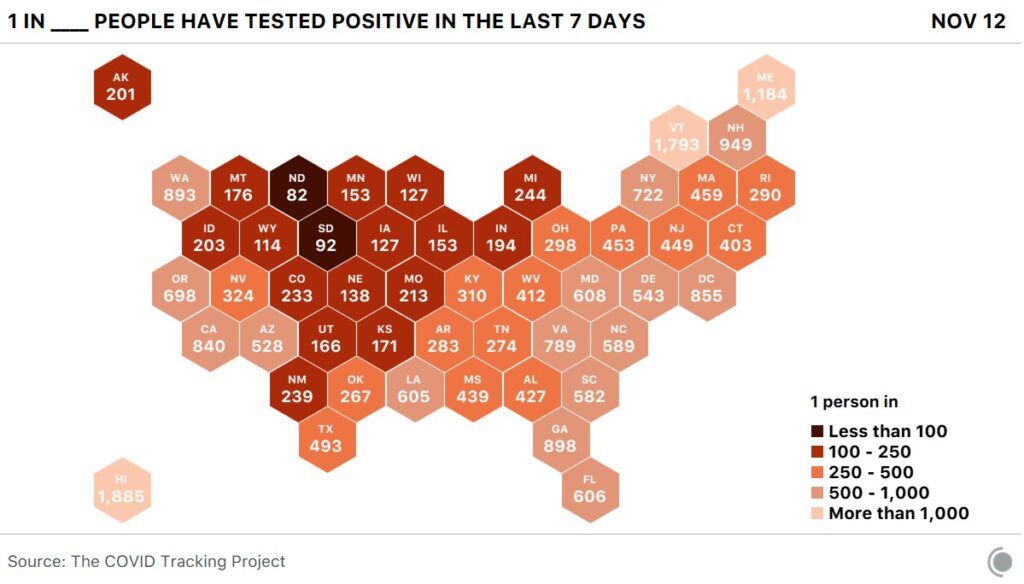
With this rapid surge in cases it is inevitable that more Americans will lose their lives at a faster pace in around 22 days (the average lag time between a rise in cases and a rise in deaths). Currently, the case fatality rate has leveled off at around 1.7%. This means that from the 181,000 new people who were diagnosed with Covid-19 on Friday, over 3,000 of them may die. Deaths are likely to increase to 2,000 per day in a few weeks.
This is an unmitigated disaster. It will continue to ravage through gatherings with family and friends. Every restriction that governments place is too late — the virus has already wrecked the community. While Americans, tired of the pandemic, revel by dining in restaurants and bars, healthcare workers are battling complete and utter exhaustion trying to save lives. There will be a breaking point, and quite possibly soon: while you can make more masks and PPE, you cannot make a doctor. In North Dakota, with hospitals at 100% capacity, the governor has allowed nurses who are currently infected with Covid-19 (and asymptomatic) to return to work. “If every day, two jumbo jets would drop from the sky and kill everybody, don’t you think that everybody would be in a panic?” Emory’s Dr. Carlos del Rio asks. “But somehow, we’re not doing that. Somehow, as a nation we’re not outraged.”
We are beginning the holidays at an unacceptable baseline rate of infections, and as a recent survey reports that nearly 40% of Americans are planning to attend large gatherings for Thanksgiving, health experts caution about a possible holiday surge. There is simply too much virus in the community. It is also quite possible that we will begin to see testing delays similar to those in the summer as labs begin to buckle under an overload.
America has failed to keep its children in school and its elderly alive. New York City’s schools are on the verge of closing due to a high city test positivity rate and nursing home deaths nationwide are on the rise. Around 10% of the Secret Service’s core security team is currently isolated or quarantined due to possible exposure during Trump campaign rallies or infections at the White House, a matter of critical national security. We continue to battle racial and other inequities in the healthcare system as lines to get tested return. In a recent survey of scientists, the U.S. scores last when it comes to policymakers listening to science to guide their decisions. In tackling the pandemic, the U.S. clearly has lost its sense of urgency.
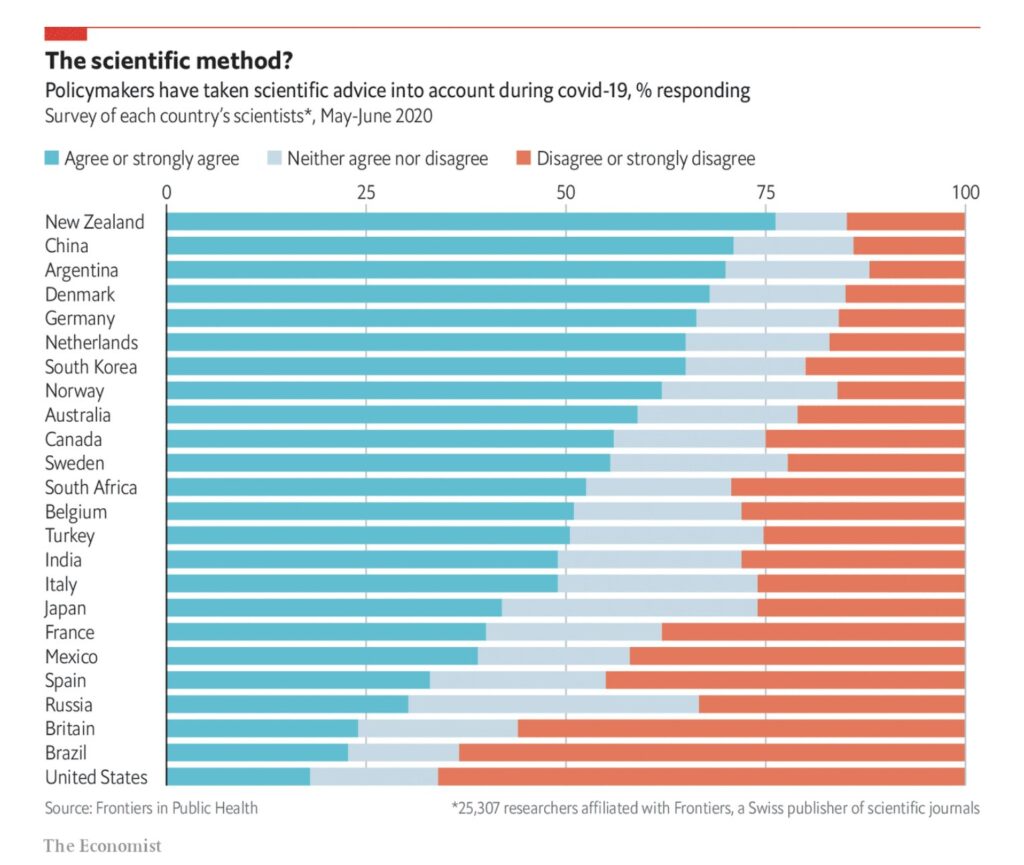
The White House has continued to struggle with controlling its own coronavirus outbreak as well. The latest update of our outbreak tracker includes 17 positives, 7 of whom confirmed to have been at the election night party. This week was critical for new cases as it was around 7 days after the party, now a probably superspreader event.
To assess our current situation, it is helpful to understand where we were with case and hospitalization growth. These charts show cases, hospitalizations and deaths per million residents this week, two weeks ago and one month ago. In almost every state, these figures are up dramatically.
The virus does not care whether you are Republican or a Democrat, what state you live in or even if you are having an indoor volleyball tournament for 20,000 people, as one city in Iowa did. With much of the American population still susceptible to this disease, we must be prepared for a painful winter.
Although his inauguration is more than two months away, President-elect Joe Biden has already begun to assemble a task force with some of the most brilliant minds in medicine and science, as well as a comprehensive plan. It is up to the American people to keep infections under control until the plan can be put into effect.
Although his inauguration is more than two months away, President-elect Joe Biden has already begun to assemble a task force with some of the most brilliant minds in medicine and science, as well as a comprehensive plan. It is up to the American people to keep infections under control until the plan can be put into effect.
Let’s take a look at some of the latest scientific developments:
- A new CDC report sheds light on possible complications in individuals’ battles with long-haul Covid-19. After discharge from an initial Covid-19 hospitalization, 9% of patients were readmitted to the same hospital within 2 months of discharge.
- Breaking from its tentative recommendations on mask use thus far, the Centers for Disease Control and Prevention said on Tuesday that using masks benefits wearers, a step beyond its previous declaration that said wearing masks would only protect those around them.
- The FDA gave emergency approval for the Eli Lilly antibody treatment.
- New Michigan hospital data show that of people admitted with Covid-19, 70% were alive and home 60 days later; of those who’d been working, 40% either lost their job or were still too sick to work.
- A Chinese model suggests that the pandemic could last through 2024.
- A new CDC report from the Maine wedding this past summer shows infection in 27 (49.1%) of 55 wedding guests and 177 Covid-19 cases in total, including seven hospitalizations and seven deaths. Some of these cases spread to a correctional facility and long-term care facility.
- Beginning in April 2020, the proportion of children’s mental health–related ED visits among all pediatric ED visits increased and remained elevated through October, according to a CDC report. Compared with 2019, the proportion of mental health–related visits for children aged 5–11 and 12–17 years increased approximately 24% and 31%, respectively.
- A new mathematical and scientific modeling study suggests testing on Day 8 of quarantine (with the possible test upon entry) can be as effective as a 14-day quarantine.
- A CDC report from airport screenings for international travelers found that symptom-based screening is largely ineffective.
- A decision analytical model published in JAMA found that missed instruction/teaching during 2020 could be associated with an estimated 5.53 million years of life lost.
- A study from Singapore published in The Lancet found increased risk of infection from: Being spoken to by an infected individual for 30+ min: (3x to 8x), exposure to more than one case (4x) and sharing a vehicle (3x).
- Using cellphone data from 1 in 3 Americans, researchers in Nature have identified the indoor public places most responsible for the spread of Covid-19 in the spring. They argue that sharply limiting the occupancy of these locales — chiefly restaurants, gyms, cafes, hotels, and houses of worship — could control the raging pandemic without resorting to lockdowns.
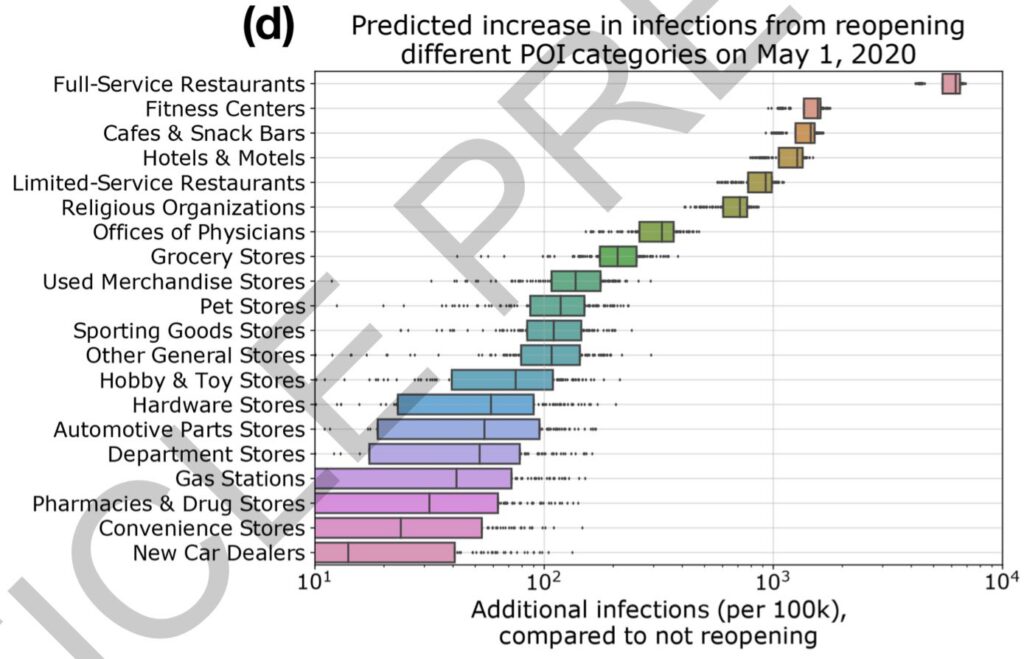
Finally, some updates on vaccines.
- Pfizer released early data that show its vaccine is 90% effective. This is a major step in the vaccine development process, especially since this vaccine is using a never-before-used messenger RNA technology. Individuals would acquire immunity seven days after two injections. There is cause for optimism as it may protect individuals from developing symptoms, but we still do not know if this vaccine can prevent against spreading the virus or contracting severe Covid-19.
- Moderna is expected to release early data from its Phase III trial shortly.
- A ProPublica analysis found that most states are not yet equipped to distribute a possible Covid-19 vaccine.
- According to STAT News, many rural hospitals lack deep refrigeration capability to store a possible Covid-19 vaccine.
The vaccine news should leave Americans optimistic; experts are predicting that ordinary Americans may be able to be vaccinated starting in April 2021. However, until then, we must do all we can to suppress transmission and break the links of this catastrophic viral spread.
Let’s move on to our discussion of higher education.
Higher education
Each Friday, I update the College Watchlist, which is currently tracking 133,638 total cases at 95 colleges across the country. At the top of my list of cases in the last 7 days are:
- Ohio State University – 481
- University of Wisconsin – 433
- Iowa State University – 344
- Arizona State University – 320
- University of Illinois – 315
With increasing community transmission nationwide, it is clear we are seeing rising case counts at most of the schools on the list to mid-September levels. The total and mean cases in the last 7 days are up and some schools are recording more cases this past week than they ever have since the start of the semester.
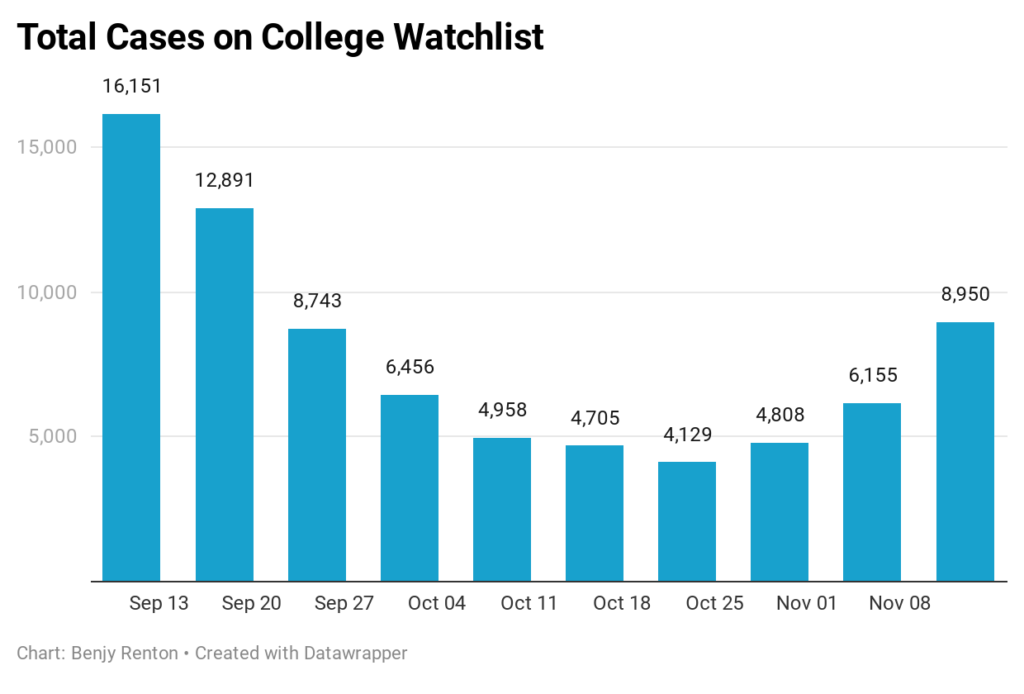
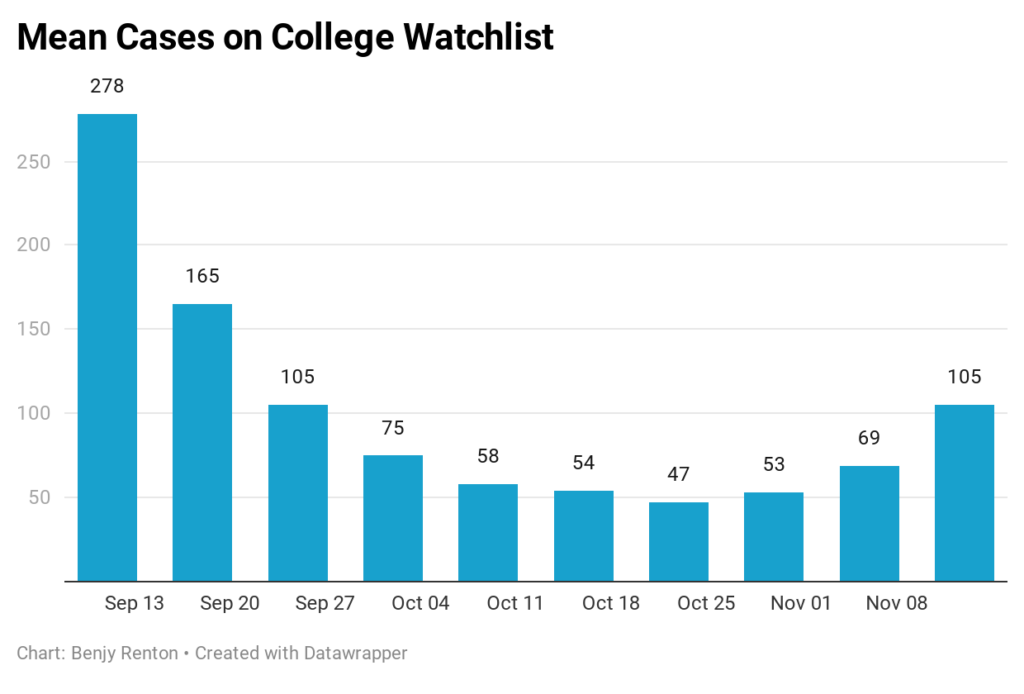
We also see a spike around November 11, around 10 days after Halloween.
Since most of the nation is currently experiencing spikes in viral spread, it is no surprise that case counts in college towns are up as well.
Here’s a roundup of this week’s higher ed news:
- Higher ed has turned its attention this week to the impending Thanksgiving break and how we can avoid spreading infections across the country. “There’s a responsibility not to unleash little ticking time bombs,” Yale professor David Paltiel says in The New York Times. Colleges have employed strategies such as exit testing (an analysis from the College Crisis Initiative at Davidson College showed that eight of out their randomly selected 100 schools are offering exit testing), grab and go meals for the road (to avoid stops on the way home) and supportive isolation and quarantine if students test positive before leaving campus.
- Over 20 schools have suspended in-person instruction or enacted campus quarantines in the last week, according to a tracker from Inside Higher Ed (that I help run). Most have been implemented as a result of rising case counts on campus.
- Albion College in Michigan gave its students less than 48 hours to leave campus after the county said it was having trouble managing student cases, and has also apparently halted its Covid-19 testing.
- The University of Wisconsin-Madison has begun to offer testing to the community in response to a surge in cases, while the State of North Carolina is providing antigen testing for its colleges before Thanksgiving.
- Notre Dame has come under fire (once again) for its students storming the field after last week’s football game and ignoring social distancing. It will require all students to be tested upon leaving.
- The Wall Street Journal’s Maya Goldman details the experiences of students studying abroad virtually.
- After experiencing a fall with cancelled breaks, student newspapers have called for a more mental health-conscious spring semester.
- The Chronicle of Higher Education’s Sarah Brown narrates the first-year experience in one of the strangest semesters higher education has seen.
- “By this time next year, a significant percentage of the American population will be vaccinated,” vaccine specialist Dr. Peter Hotez says. “In terms of opening up colleges, definitely by next fall semester things are going to look pretty much like they have in the past.”
- A new study published in The New England Journal of Medicine details Covid-19 transmission among Marine Corps recruits on a college campus. The Wall Street Journal’s Sarah Toy reports on the story in The Wall Street Journal here. Recruits were instructed to quarantine for 14 days before arriving and were placed in double rooms upon arrival. Mask wearing and social distancing were all in place throughout and tests were conducted on arrival, 7 days and 14 days. After 14 days, tests found 77 positives, 51 of which were in the study group. Covid-19 was often spread among roommates. All 51 cases of Covid-19 in the study group were picked up by the prescheduled tests. None was detected as a result of additional tests given to individuals who reported symptoms and only 9.8% of positive individuals in the study group had symptoms. It is quite possible that Covid-19 was transmitted immediately following arrival and set off chains for the next two weeks. “Room quarantine” (where all students are in their rooms) until the first tests come back could be useful. In short: Symptom-based screening as the sole strategy will not work. We must think of college health as a Swiss cheese model — using multiple interventions simultaneously to drive down transmission.
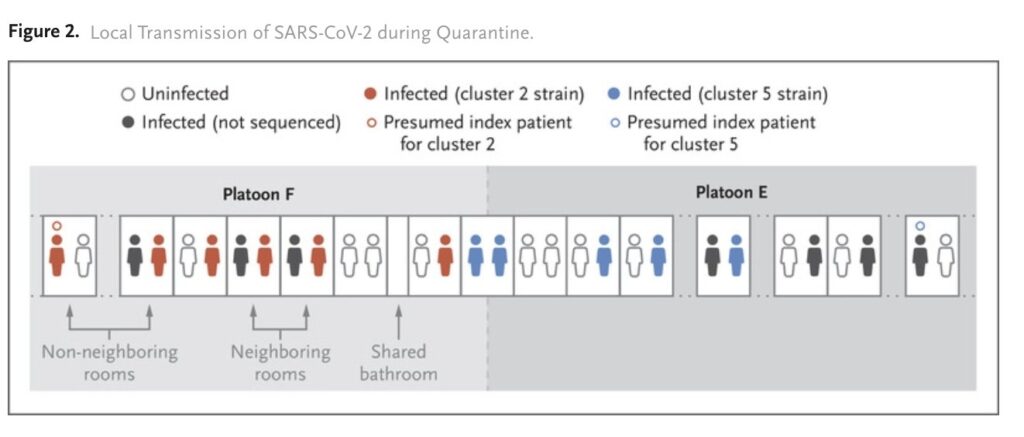
It is a sprint to the finish for many colleges as they prepare to end in-person instruction for Thanksgiving. Higher education has a responsibility to the rest of the country to minimize transmission as much as possible for students returning home, and each student has their own role to play.
The Good Stuff
Let’s roll the clips of the good stuff. In my usual tradition, I feature my favorite stories from the week. Here are my Top 10.
- The New York Times profiled Dr. Ugur Sahin and Dr. Özlem Türeci, a husband-and-wife team behind the Pfizer vaccine.
- Gap says it saw a spike in sales of khaki pants because of MSNBC’s Steve Kornacki’s election week coverage and his trademark look.
- President-elect Joe Biden will restore a White House tradition of presidential pets with his two German shepherds.
- Vice President-elect Kamala Harris’ ancestral village in India celebrated her victory with firecrackers and prayers.
- Day and night, under historic scrutiny, the nation’s vote counters and poll workers carried on through a marathon of an election.
- The mayor of a small Japanese town has become an internet sensation after it was observed that the characters of his name can be read as “Jo Baiden,” phonetically the same as president-elect Joe Biden.
- Scientists have now found that platypuses glow under backlight.
- Cornell University’s student newspaper found a surge in liquor store sales following the election.
- A sick swan in New York is saved after a 23-mile odyssey by foot, car and subway.
- The Washington Post published an excellent oral history of the four-year movement to defeat Donald Trump.
Conclusion
America’s darkest days are still ahead of us. We are entering the holiday season at a baseline that is too high for our healthcare system to sustain. At this rate we will approach 200,000 daily cases by next week and hospitals in many places have already been overwhelmed. Slow government action, and complete federal inaction, will result in a new projected scenario by the Institute for Health Metrics and Evaluation of 438,941 Covid-19 deaths by March 1, 2021.
This Thanksgiving, stay home. Drop off food for your older relatives and rejoice together virtually. The risk is too great in much of the country for any gathering, where social distancing and mask wearing are often not followed. A vaccine is on the horizon and initial data are promising, but we must prepare for extreme agony in the coming weeks and months before a new president can change our course.
I’d like to thank all the student journalists with whom I have the pleasure of working. In the next weeks and months ahead, they will become vital in chronicling their colleges’ paths forward for the fall and beyond. Support their work by reading it.
My best to all for good health.
Like what you see? Don’t like what you see? Want to see more of something? Want to see less of something? Let me know in the comments. And don’t forget to subscribe to the weekly newsletter!
For more instant updates, follow me on Twitter @bhrenton.


